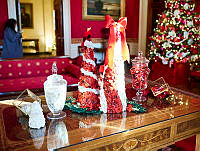Pathbreakers: Oscar Stanton DePriest and Jessie L. Williams DePriest
Copyright © White House Historical Association. All rights reserved under international copyright conventions. No part of this article may be reproduced or utilized in any form or by any means, electronic or mechanical, including photocopying, recording, or by any information storage and retrieval system, without permission in writing from the publisher. Requests for reprint permissions should be addressed to books@whha.org

Portrait of Oscar DePriest outside the Capitol, 1929. Oscar S. DePriest, described as being six feet tall, weighing 200 pounds, having a light complexion, sandy hair and blue eyes, represented more than the First District of Illinois from 1929 to 1934 from which he had been elected. He became the only voice in Congress for twelve million black Americans.
Shelley Stokes-Hammond prepared these biographical sketches as part of a project for a graduate documentation course at Goucher College where she received a Master of Arts in Historic Preservation in 2011.
In March 1929, Oscar Stanton DePriest became the first African American to serve in the United States Congress since George H. White of North Carolina left the House in 1901. DePriest was also the first black member from a northern state with fast-growing urban industrial cities to be elected to Congress.
Oscar S. DePriest was born in a cabin in Florence, Alabama, on March 9, 1871, to Alexander and Mary Karsner DePriest, both of who had been slaves. Once freed, his father worked as a part-time farmer while running a hauling business and his mother found employment as a laundress. Alexander DePriest helped shelter black Republican Congressman James T. Rapier from a lynch mob during Reconstruction. Not withstanding the threat to his livelihood, Alexander DePriest stood firm. He also refused to shift from the Republican party of Lincoln to Democrat despite pressure from the former Confederates who had regained control of state government. Nevertheless, when seven-year-old Oscar discovered a neighbor, who had been lynched and riddled with bullets, the family decided to migrate to Salina, Kansas.
Like many blacks, the DePriest family moved northward to escape the dire social and economic conditions for blacks in the south during Reconstruction. Oscar DePriest had received some education in a Congregational church school for freedmen in Florence. He also attended public schools and studied bookkeeping in the Salina Normal School while working in the wheat fields. At seventeen, Oscar moved to Dayton, Ohio, and a year later to Chicago where he earned a living as a painter, decorator, plasterer, and eventually, a realtor. DePriest became affluent through his real estate business and investments in the stock market. On February 23, 1898, DePriest married Jessie L. Williams of Rockford, Illinois.

Standing portrait of Jessie DePriest taken by renowned black photographer Addison Scurlock on the day of the “Tea Incident,” June 12, 1929. Jessie Williams DePriest by all accounts was a well-educated, gracious, and polite woman. Dressed elegantly in the fashion of the time, her look conveyed style, grace and dignity providing an antithesis to debasing stereotypical depictions of African Americans.
Little is known about the young life of Jessie Williams DePriest. Born on September 3, 1870, Jessie was the daughter of James and Emma Williams who were both originally from Pennsylvania. James born in 1840, worked as a farmer, and was listed as white on the 1880 Federal Census. His wife, Emma, recorded as a housewife and classified as a Mulatto, was born in 1839. Apparently, Jessie was a music teacher before she married Oscar. The DePriests had two children, Laurence who was born in 1900, but he drowned in an accident at the age of sixteen, and Oscar, Jr. who lived a full life and had a son whom he named Oscar Stanton DePriest, III.
Oscar DePriest’s career in public service began with his 1904 election to the board of commissioners of Cook County, Illinois. He then served on the Chicago City Council from 1915 to 1917 as alderman from Ward 2. DePriest founded a powerful political organization called the People’s Movement Club.
When Representative Martin B. Madden died of a heart attack suddenly after securing the Republican nomination to his 13th term in Congress, the Republican machine led by the Mayor William Hale “Big Bill” Thompson supported DePriest for the seat.1 After narrowly defeating several black opponents, DePriest was sworn into Congress on April 15, 1929. Proud black spectators and the press crowded the House’s public gallery. The local press reported a rumor that an attempt would be made to keep DePriest from being seated in the House due to “charges of sponsoring and protecting vice and gambling in the colored section of Chicago’s South Side.” DePriest demanded the State Attorney bring the case to trial on four occasions and, after the office admitted it was not prepared to proceed, a judge dismissed the case just days before the swearing-in ceremony.2 By administering the oath en masse rather than individually, the speaker preempted any member sworn in before DePriest from challenging his legality as a member of the 71st Congress. Reportedly, Alice Longworth, the daughter of President Theodore Roosevelt, influenced her husband’s decision with the urging of Ruth Hanna McCormick, a good friend and newly elected member of the House from Illinois. DePriest endured the blatant discrimination of new southern members who refused to accept assigned offices adjacent to the black congressman. Other members like Representative Fiorello LaGuardia of New York implored his colleagues to be welcoming and supportive.3

Oscar DePriest to Lt. Collins, April 20, 1944. Oscar DePriest wrote hundreds of letters on behalf of his constituents during his time in office.
DePriest served in the 71st, 72nd, and 73rd sessions of Congress where he was assigned to less prestigious committees on Indian Affairs, Invalid Pensions, Enrolled Bills, Post Office and Post Roads. Though limited in his legislative achievements, Congressman DePriest challenged segregation and racial discrimination and was a staunch advocate of the enforcement of the 14th amendment.
He fought for blacks to dine in the House Restaurant rather than being confined to a separate facility next to the kitchen in the basement of the House. DePriest favored the reduction in the number of seats in the House for states that disfranchised blacks, as George H. White had done years earlier. He attempted to honor and assist former slaves who were seventy-five years and older by giving them a federal pension. The congressman advocated that federal courts be authorized to change the location of a trial if a defendant’s right to impartiality was at risk due to matters of race, color or creed as in the infamous 1931 Scottsboro trial where 9 black teenagers had been accused of a gang rape of two white girls.
He introduced legislation to make states and counties responsible for the prevention of lynching and spoke ardently for these causes all throughout the south despite threats on his life. DePriest opposed discrimination in applying unemployment relief within the Civilian Conservation Corps and was a champion for Howard University and other Historically Black Colleges and Universities. Finally, when newspaper headlines mocked the attendance of his wife at the White House for tea at the invitation of Mrs. Hoover, he forcefully defended her right, respect, and dignity as the wife of a congressman.
Newspapers throughout the nation published the Associated Press report of DePriest’s fiery reaction:
"DePriest said the criticism of Mrs. Hoover’s receiving Mrs. DePriest at the White House tea was an incident used by southern Democratic politicians, seeking to win the solid south back into Democratic party.…“I want to thank the Democrats of the south for one thing. They were so barbaric they drove my parents to the north. If it had not been for that I wouldn’t be in Congress today. I’ve been Jim Crowed, segregated, persecuted, and I think I know how best the Negro can put a stop to being imposed upon. It is through the ballot, through organization, through eternally fighting for his rights."4
DePriest’s bid for a fourth term in 1932 received national attention because of his position as the only black in Congress and that his New Deal Democratic opponent, Arthur Mitchell, was also black. Mitchell strongly supported President Franklin D. Roosevelt’s federal relief programs whereas DePriest adopted the Republican position on economic relief as best emanating from the states and local communities. DePriest, defeated by Mitchell, returned to Chicago in 1934 where he resumed activities in real estate and politics. Congressman DePriest died at the age of eighty on May 19, 1951, following complications from a bus accident. His wife, Jessie, lived ten years on after her husband’s death, and passed away at the age of ninety on March 31, 1961, due to a stroke.5

Oscar DePriest poses in front of a plane located on an airfield in Los Angeles, 1929. Oscar DePriest was part of the Bessie Coleman’s Aero Clubs, established to honor the memory of Bessie Coleman, the first African-American woman to earn an international pilot’s license. The image is inscribed, “Compliments of your friends of Bessie Coleman Aero Clubs 1423 St. Jefferson Blvd., Los Angles Calif, 9-30-1929.”

Current image of the Oscar S. DePriest House in Chicago. In 1921, Oscar DePriest’s house located at 3815 Vernon Avenue had been fire bombed over a dispute concerning an apartment house he owned between segregated neighborhoods.
From Chicago’s Grand Boulevard to Washington, D.C.’s LeDroit Park
At the time of DePriest’s election to Congress, he lived with his wife in an all-black neighborhood on the South Side of Chicago at 4536-4538 South Parkway (now Martin Luther King, Jr. Drive).
The second floor of the 1920 eight-flat apartment in the Grand Boulevard community became their residence in 1921, but the DePriests owned the entire complex. The property remains a part of the DePriest family trust and was registered as a National Historic Landmark in 1975.
When the DePriests moved to Washington, D.C., in 1929, they moved to LeDroit Park at 419 U Street, Northwest. The DePriest House was one of forty-one substantial Italianate, Gothic, and Second Empire style detached and semi-detached villas in an exclusive community designed and built by Washington architect James H. McGill between 1873 and 1877. Convenient to Howard University and the Howard Theater, the community’s expansion in the late nineteenth century spurred a population change. About 1901 the neighborhood began to evolve into the pleasant upper-middle class haven for the city’s black social, educational, and cultural leaders that the DePriests would have known.
DePriest’s immediate neighbors included Dr. Garnet C. Wilkinson (406 U Street), Assistant Superintendent of Colored Schools in the District until 1954; Clara Taliaferro (414 U Street), a pharmacist and daughter of lawyer and educator John H. Smyth, a former ambassador to Liberia in 1890; Percy A. Roy (417 U Street) a craftsman, artisan, and manual arts teacher at Armstrong High School famous for his exquisite flower gardens; James M. Carter (402 U Street), an English professor at Howard University; and famous black photographer Addison Scurlock had a studio (900 U Street) nearby.6
The DePriests left 419 U Street toward the end of his last term and moved to 1923 15th Street, Northwest, where they lived until they returned to Chicago in 1934. When they left the residence on 15th Street, family lore recorded that the new owners found hundreds of copies of the Declaration of Independence. Shortly after being sworn into Congress, Congressman DePriest sent out to constituents 10,000 copies to constituents of the Declaration of Independence and the Constitution of the United States. Mr. DePriest argued that rather than social equality, he sought to achieve "equal justice under the law." For the rest of his life, whenever the opportunity presented itself, he would hand out a copy of these two precious American documents.7






























































